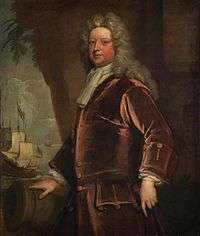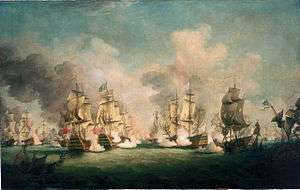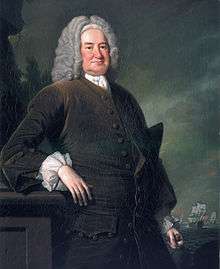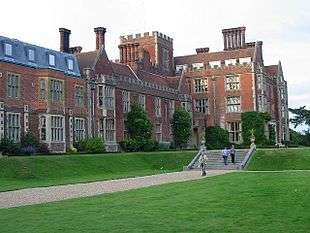John Norris (Royal Navy officer)
| Sir John Norris | |
|---|---|
 John Norris by Godfrey Kneller in 1711 | |
| Nickname(s) | Foul-weather Jack |
| Born | 1670 or 1671 |
| Died |
13 June 1749 Hemsted Park, Benenden, Kent |
| Buried | St George's Church, Benenden, Kent |
| Allegiance |
|
| Service/ |
|
| Years of service | 1680–1734 |
| Rank | Admiral of the Fleet |
| Commands held |
HMS Pelican HMS Spy HMS Sheerness HMS Royal Oak HMS Sussex HMS Russell HMS Carlisle HMS Content HMS Winchester HMS Orford HMS Britannia |
| Battles/wars |
Nine Years' War Williamite War in Ireland War of the Spanish Succession Great Northern War War of Jenkins' Ear |
Admiral of the Fleet Sir John Norris PC (1670 or 1671 – 13 June 1749) was a Royal Navy officer. After serving as a junior officer during the Nine Years' War and the Williamite War in Ireland, he was given command of a squadron sent to North America to protect British settlements on the banks of Hudson Bay in 1697. Although he developed a plan to recapture some territories in Newfoundland and Labrador taken by French forces the previous winter, he was prevented from implementing that plan when the local council overruled him.
Norris served under Admiral Sir George Rooke at the Battle of Cádiz at an early stage of the War of the Spanish Succession. He went on to command the vanguard at the Battle of Malaga in August 1704 and then served under Admiral the Earl of Peterborough at the capture of Barcelona in October 1705.
As a flag officer, Norris was sent with a fleet to the Baltic Sea to support a coalition of naval forces from Russia, Denmark and Hanover taking in the Great Northern War. Tsar Peter took personal command of the coalition fleet and appointed Norris as his deputy in 1716: together they protected British and other allied merchant vessels from attack by warships of the Swedish Empire. In November 1718, following the death of Charles XII of Sweden, Britain switched sides and Norris returned to the region to protect British merchant shipping from attack by Russian raiders. Norris also acted as a commissioner in the negotiations leading to the Treaty of Nystad which ended the War in September 1721.
Norris went on to be commander-in-Chief of the Channel Fleet at the outset of the War of Jenkins' Ear in 1739. In 1744 he was asked to defend Britain from an imminent French Invasion: he was preparing for battle against the French fleet, when storms intervened scattering the invasion transports, with heavy loss of life, thereby ending the immediate threat of invasion.
Early career

Born of uncertain Irish parentage, Norris joined the Royal Navy as a captain’s servant in 1680.[1] Promoted to lieutenant in August 1689, he joined the third-rate HMS Edgar commanded by Cloudesley Shovell during the Nine Years' War.[2] He transferred to the third-rate HMS Monck early in 1690 and served off the Coast of Ireland during the Williamite War in Ireland.[2] Promoted to commander on 8 July 1690, he was given command of the fire ship HMS Pelican and took part in the Battle of Beachy Head in July 1690 in another action of the Nine Years' War.[2] He transferred to the command of the fire ship HMS Spy in December 1691 and saw action again at the Battles of Barfleur and La Hogue in May 1692.[2]
Promoted to captain on 13 January 1693, Norris was given command of the fifth-rate HMS Sheerness and fought at the Battle of Lagos in June 1693.[2] He transferred to the command of the third-rate HMS Royal Oak, then to the command of the third-rate HMS Sussex and then to the command of the second-rate HMS Russell and was deployed to the Mediterranean early in 1694.[2] He transferred to the command of the fourth-rate HMS Carlisle and then to the command of the third-rate HMS Content in Spring 1695.[2]
Norris was given command of a squadron sent to North America to protect British settlements on the banks of Hudson Bay in 1697.[3] Although he developed a plan to recapture some territories in Newfoundland and Labrador taken by French forces the previous winter, he was prevented from implementing that plan when the local council overruled him and he received some criticism when he returned to England for his inaction.[1] However he was defended by the Earl of Orford from potential dismissal,[4] his successful career continued and he was given command of the fourth-rate HMS Winchester later in 1697.[3] Investigations were restarted into his conduct in Newfoundland in early 1699 he was suspended from the navy in April 1699.[4]
Norris was given command of the third-rate HMS Orford early in 1702 and served under Admiral Sir George Rooke at the Battle of Cádiz in August 1702 at an early stage of the War of the Spanish Succession.[3] He went on to command the vanguard at the Battle of Malaga in August 1704.[3] He was given command of the first-rate HMS Britannia, flagship of Admiral Sir Cloudesley Shovell, in 1703 and then served under Admiral the Earl of Peterborough at the capture of Barcelona in October 1705.[3] Following his return to England he was knighted on 5 November 1705.[3]
Senior command

Promoted to rear admiral on 10 March 1707, Norris became second-in-command of the Mediterranean Fleet, with his flag in the third rate HMS Torbay.[3] After taking part in the British defeat at the Battle of Toulon in July 1707 and, while sailing aboard his flagship HMS Torbay, Norris was present during the great naval disaster off the Isles of Scilly in October 1707 when Shovell and four of his ships were lost, claiming the lives of nearly 2,000 sailors.[5] Promoted to vice admiral on 26 January 1708, Norris transferred his flag to the third-rate HMS Ranelagh and became Member of Parliament for Rye later in the year.[6] While still serving as second-in-command of the Mediterranean Fleet, he took personal charge a squadron deployed to the Baltic Sea to prevent Swedish grain arriving in France in 1709.[3] Promoted to full admiral on 21 December 1709, he became Commander-in-Chief of the Mediterranean Fleet early in 1710.[3]
In 1715 Norris was sent with a fleet to the Baltic Sea to support a coalition of naval forces from Russia, Denmark and Hanover taking in the Great Northern War.[3] Tsar Peter took personal command of the coalition fleet and appointed Norris as his deputy in 1716: together they protected British and other allied merchant vessels from attack by warships of the Swedish Empire.[3] Norris joined the Board of Admiralty led by the Earl of Berkeley in March 1718.[7] In November 1718, following the death of Charles XII of Sweden, Britain switched sides and Norris returned to the region to protect British merchant shipping from attack by Russian raiders.[8] Norris also acted as a commissioner in the negotiations leading to the Treaty of Nystad which ended the War in September 1721.[8] He became Member of Parliament for Portsmouth in March 1722[9] and was advanced to Senior Naval Lord on the Admiralty Board in June 1727[10] but stood down as a Lord Commissioner of the Admiralty when the Walpole–Townshend Ministry fell in May 1730.[7]

Norris was promoted to Admiral of the Fleet on 20 February 1734 and, with his flag in HMS Britannia, he became commander-in-chief of a fleet sent to the Iberian Peninsula to protect Portugal from Spanish attack.[8] He became Member of Parliament for Rye again in April 1734,[11] was appointed Vice-Admiral of Great Britain in April 1739[12] and went on to be Commander-in-Chief of the Channel Fleet at the outset of the War of Jenkins' Ear in Autumn 1739.[8]
In 1744 Norris was asked to defend Britain from an imminent French Invasion and in 1745 made Captain of Deal Castle: he was preparing for battle against the French fleet, when storms intervened scattering the invasion transports, with heavy loss of life, thereby ending the immediate threat of invasion.[8] Norris retired from the navy later in the year.[8]
Norris died at his country home, Hemsted Park in Kent, on 13 June 1749 and was buried at St George's Church in Benenden.[6]
Family
In May 1699 Norris married Elizabeth Aylmer, daughter of Admiral Matthew Aylmer;[6] they had five children (including Vice Admiral Henry Norris[13] and Captain Richard Norris).[8] His granddaughter was the art collector and amateur artist John Norris Hewett.[14]
References
- 1 2 Godfrey, Michael (1974). "Norris, Sir John". In Halpenny, Francess G. Dictionary of Canadian Biography. III (1741–1770) (online ed.). University of Toronto Press.
- 1 2 3 4 5 6 7 Heathcote, p. 195
- 1 2 3 4 5 6 7 8 9 10 11 Heathcote, p. 196
- 1 2 Aldridge, p. 47
- ↑ Sobel, p. 6
- 1 2 3 "John Norris". Oxford Dictionary of National Biography. Retrieved 9 May 2015.
- 1 2 "Sainty, JC, Lord High Admiral and Commissioners of the Admiralty 1660-1870', Office-Holders in Modern Britain: Volume 4: Admiralty Officials 1660-1870 (1975), pp. 18-31". Retrieved 9 May 2015.
- 1 2 3 4 5 6 7 Heathcote, p. 197
- ↑ "No. 6045". The London Gazette. 24 March 1722. p. 3.
- ↑ Rodger, p. 51-52
- ↑ "No. 7292". The London Gazette. 31 March 1739. p. 3.
- ↑ "No. 7793". The London Gazette. 31 March 1739. p. 1.
- ↑ Burke, p. 180
- ↑ "John Norris Hewett, a singular woman". 19 October 2016. Retrieved 28 August 2017.
Sources
- Aldridge, David (2009). Admiral Sir John Norris and the British Naval Expeditions to the Baltic Sea 1715–1727 (PDF). Nordic Academic Press. ISBN 978-91-85509-31-7.
- Burke, John (2010). A Genealogical and Heraldic History of the Extinct and Dormant Baronetcies of England. Nabu Press. ISBN 978-1146796750.
- Heathcote, Tony (2002). The British Admirals of the Fleet 1734–1995. Pen & Sword. ISBN 0-85052-835-6.
- Rodger, N.A.M. (1979). The Admiralty. Offices of State. Lavenham: T. Dalton Ltd. ISBN 0900963948.
- Sobel, Dava (1998). Longitude: The True Story of a Lone Genius Who Solved the Greatest Scientific Problem of His Time. Fourth Estate, London. ISBN 1-85702-571-7.
Further reading
- Nordisk familjebok


External links
- John Norris Three Decks
| Parliament of Great Britain | ||
|---|---|---|
| Preceded by Edward Southwell Phillips Gybbon |
Member of Parliament for Rye 1708–1722 With: Phillips Gybbon |
Succeeded by Phillips Gybbon The Lord Aylmer |
| Preceded by Sir Edward Ernle, Bt Sir Charles Wager |
Member of Parliament for Portsmouth 1722–1734 With: Sir Charles Wager |
Succeeded by Thomas Lewis Philip Cavendish |
| Preceded by Phillips Gybbon Matthew Norris |
Member of Parliament for Rye 1734–1749 With: Phillips Gybbon |
Succeeded by Phillips Gybbon Thomas Pelham |
| Military offices | ||
| Preceded by Sir John Jennings |
Senior Naval Lord 1727–1730 |
Succeeded by Sir Charles Wager |
| Preceded by Sir George Byng |
Admiral of the Fleet 1734–1749 |
Succeeded by Sir Chaloner Ogle |
| Honorary titles | ||
| Preceded by Unknown |
Vice-Admiral of Great Britain 1739–1749 |
Succeeded by The Lord Anson |